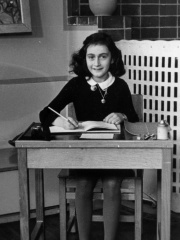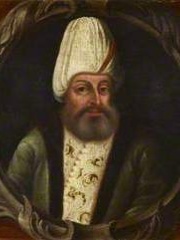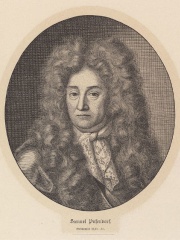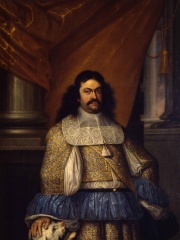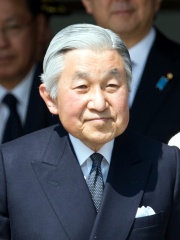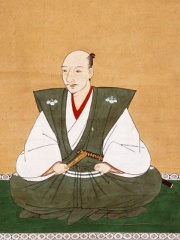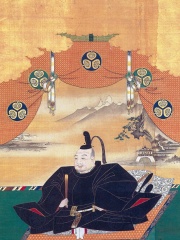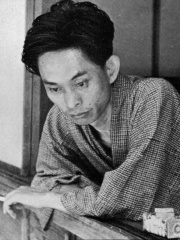WRITER
Matsuo Bashō
1644 - 1694

 Matsuo Bashō
Matsuo Bashō
Matsuo Bashō (松尾 芭蕉; Japanese pronunciation: [ma.tsɯ.o (|) ba.ɕoː], 1644 – November 28, 1694); born Matsuo Kinsaku (松尾 金作), later known as Matsuo Chūemon Munefusa (松尾 忠右衛門 宗房) was the most famous Japanese poet of the Edo period. During his lifetime, Bashō was recognized for his works in the collaborative haikai no renga form; today, after centuries of commentary, he is recognized as the greatest master of haiku (then called hokku). He is also well known for his travel essays beginning with Records of a Weather-Exposed Skeleton (1684), written after his journey west to Kyoto and Nara. Matsuo Bashō's poetry is internationally renowned, and, in Japan, many of his poems are reproduced on monuments and traditional sites. Read more on Wikipedia
His biography is available in 163 different languages on Wikipedia (up from 159 in 2024). Matsuo Bashō is the 39th most popular writer (up from 96th in 2024), the 2nd most popular biography from Japan (up from 9th in 2019) and the most popular Japanese Writer.
Matsuo Bashō is most famous for his work "Oku no Hosomichi" which is a travelogue of his journey through Japan.
Memorability Metrics
Page views of Matsuo Bashō by language
Among WRITERS
Among writers, Matsuo Bashō ranks 39 out of 7,302. Before him are Agatha Christie, H. G. Wells, Khalil Gibran, Anne Frank, George Orwell, and Charles Dickens. After him are Hermann Hesse, Emily Dickinson, Ernest Hemingway, Horace, F. Scott Fitzgerald, and Alexander Pushkin.
Most Popular Writers in Wikipedia
Go to all RankingsAgatha Christie
1890 - 1976
HPI: 85.80
Rank: 33
H. G. Wells
1866 - 1946
HPI: 85.76
Rank: 34
Khalil Gibran
1883 - 1931
HPI: 85.57
Rank: 35
Anne Frank
1929 - 1945
HPI: 85.31
Rank: 36
George Orwell
1903 - 1950
HPI: 85.28
Rank: 37
Charles Dickens
1812 - 1870
HPI: 85.20
Rank: 38
Matsuo Bashō
1644 - 1694
HPI: 85.14
Rank: 39
Hermann Hesse
1877 - 1962
HPI: 85.13
Rank: 40
Emily Dickinson
1830 - 1886
HPI: 85.12
Rank: 41
Ernest Hemingway
1899 - 1961
HPI: 84.99
Rank: 42
Horace
65 BC - 8 BC
HPI: 84.80
Rank: 43
F. Scott Fitzgerald
1896 - 1940
HPI: 84.65
Rank: 44
Alexander Pushkin
1799 - 1837
HPI: 84.64
Rank: 45
Contemporaries
Among people born in 1644, Matsuo Bashō ranks 1. After him are Antonio Stradivari, Ole Rømer, Henrietta of England, Louise de La Vallière, Heinrich Ignaz Franz Biber, Marie Jeanne Baptiste of Savoy-Nemours, Galdan Boshugtu Khan, Jakob Ammann, Louis-François de Boufflers, François de Neufville, duc de Villeroy, and Amcazade Köprülü Hüseyin Pasha. Among people deceased in 1694, Matsuo Bashō ranks 2. Before him is Mary II of England. After him are Marcello Malpighi, Samuel von Pufendorf, Natalya Naryshkina, Antoine Arnauld, Francesco Morosini, Ranuccio II Farnese, Duke of Parma, Suleiman of Persia, John George IV, Elector of Saxony, Hishikawa Moronobu, and Pierre Puget.
Others Born in 1644
Go to all RankingsMatsuo Bashō
WRITER
1644 - 1694
HPI: 85.14
Rank: 1
Antonio Stradivari
DESIGNER
1644 - 1737
HPI: 81.39
Rank: 2
Ole Rømer
ASTRONOMER
1644 - 1710
HPI: 77.72
Rank: 3
Henrietta of England
NOBLEMAN
1644 - 1670
HPI: 74.37
Rank: 4
Louise de La Vallière
WRITER
1644 - 1710
HPI: 71.41
Rank: 5
Heinrich Ignaz Franz Biber
MUSICIAN
1644 - 1704
HPI: 70.59
Rank: 6
Marie Jeanne Baptiste of Savoy-Nemours
POLITICIAN
1644 - 1724
HPI: 68.85
Rank: 7
Galdan Boshugtu Khan
MILITARY PERSONNEL
1644 - 1697
HPI: 66.23
Rank: 8
Jakob Ammann
RELIGIOUS FIGURE
1644 - 1730
HPI: 65.51
Rank: 9
Louis-François de Boufflers
POLITICIAN
1644 - 1711
HPI: 65.12
Rank: 10
François de Neufville, duc de Villeroy
POLITICIAN
1644 - 1730
HPI: 64.02
Rank: 11
Amcazade Köprülü Hüseyin Pasha
POLITICIAN
1644 - 1702
HPI: 62.09
Rank: 12
Others Deceased in 1694
Go to all RankingsMary II of England
POLITICIAN
1662 - 1694
HPI: 86.29
Rank: 1
Matsuo Bashō
WRITER
1644 - 1694
HPI: 85.14
Rank: 2
Marcello Malpighi
PHYSICIAN
1628 - 1694
HPI: 74.93
Rank: 3
Samuel von Pufendorf
HISTORIAN
1632 - 1694
HPI: 71.49
Rank: 4
Natalya Naryshkina
POLITICIAN
1651 - 1694
HPI: 68.92
Rank: 5
Antoine Arnauld
PHILOSOPHER
1612 - 1694
HPI: 68.65
Rank: 6
Francesco Morosini
POLITICIAN
1619 - 1694
HPI: 68.00
Rank: 7
Ranuccio II Farnese, Duke of Parma
POLITICIAN
1630 - 1694
HPI: 67.27
Rank: 8
Suleiman of Persia
POLITICIAN
1647 - 1694
HPI: 67.00
Rank: 9
John George IV, Elector of Saxony
POLITICIAN
1668 - 1694
HPI: 66.04
Rank: 10
Hishikawa Moronobu
PAINTER
1618 - 1694
HPI: 65.82
Rank: 11
Pierre Puget
PAINTER
1620 - 1694
HPI: 65.40
Rank: 12
In Japan
Among people born in Japan, Matsuo Bashō ranks 2 out of 6,245. Before him are Hirohito (1901). After him are Hokusai (1760), Hayao Miyazaki (1941), Akihito (1933), Oda Nobunaga (1534), Akira Kurosawa (1910), Tokugawa Ieyasu (1542), Emperor Meiji (1852), Miyamoto Musashi (1584), Naruhito (1960), and Toyotomi Hideyoshi (1536).
Others born in Japan
Go to all RankingsHirohito
POLITICIAN
1901 - 1989
HPI: 85.25
Rank: 1
Matsuo Bashō
WRITER
1644 - 1694
HPI: 85.14
Rank: 2
Hokusai
ARTIST
1760 - 1849
HPI: 84.61
Rank: 3
Hayao Miyazaki
FILM DIRECTOR
1941 - Present
HPI: 83.44
Rank: 4
Akihito
NOBLEMAN
1933 - Present
HPI: 83.28
Rank: 5
Oda Nobunaga
MILITARY PERSONNEL
1534 - 1582
HPI: 82.89
Rank: 6
Akira Kurosawa
FILM DIRECTOR
1910 - 1998
HPI: 82.76
Rank: 7
Tokugawa Ieyasu
MILITARY PERSONNEL
1542 - 1616
HPI: 82.57
Rank: 8
Emperor Meiji
POLITICIAN
1852 - 1912
HPI: 82.26
Rank: 9
Miyamoto Musashi
WRITER
1584 - 1645
HPI: 81.76
Rank: 10
Naruhito
NOBLEMAN
1960 - Present
HPI: 81.60
Rank: 11
Toyotomi Hideyoshi
POLITICIAN
1536 - 1598
HPI: 81.12
Rank: 12
Among WRITERS In Japan
Among writers born in Japan, Matsuo Bashō ranks 1. After him are Miyamoto Musashi (1584), Haruki Murakami (1949), Yukio Mishima (1925), Yasunari Kawabata (1899), Murasaki Shikibu (973), Osamu Dazai (1909), Kenzaburō Ōe (1935), Ryūnosuke Akutagawa (1892), Natsume Sōseki (1867), Kazuo Ishiguro (1954), and Sei Shōnagon (966).
Matsuo Bashō
1644 - 1694
HPI: 85.14
Rank: 1
Miyamoto Musashi
1584 - 1645
HPI: 81.76
Rank: 2
Haruki Murakami
1949 - Present
HPI: 80.40
Rank: 3
Yukio Mishima
1925 - 1970
HPI: 79.92
Rank: 4
Yasunari Kawabata
1899 - 1972
HPI: 79.61
Rank: 5
Murasaki Shikibu
973 - 1014
HPI: 78.63
Rank: 6
Osamu Dazai
1909 - 1948
HPI: 76.80
Rank: 7
Kenzaburō Ōe
1935 - 2023
HPI: 76.20
Rank: 8
Ryūnosuke Akutagawa
1892 - 1927
HPI: 75.67
Rank: 9
Natsume Sōseki
1867 - 1916
HPI: 72.84
Rank: 10
Kazuo Ishiguro
1954 - Present
HPI: 71.66
Rank: 11
Sei Shōnagon
966 - 1025
HPI: 71.53
Rank: 12



